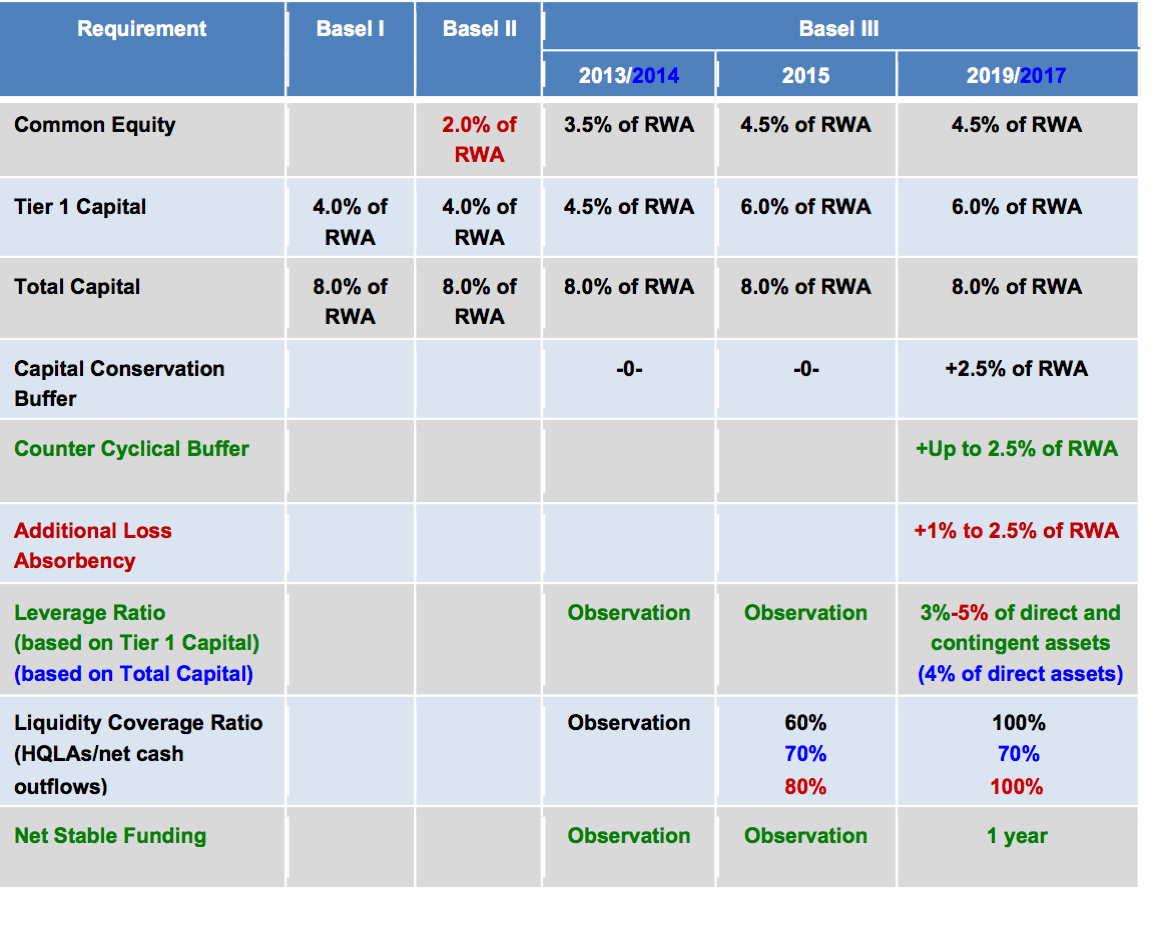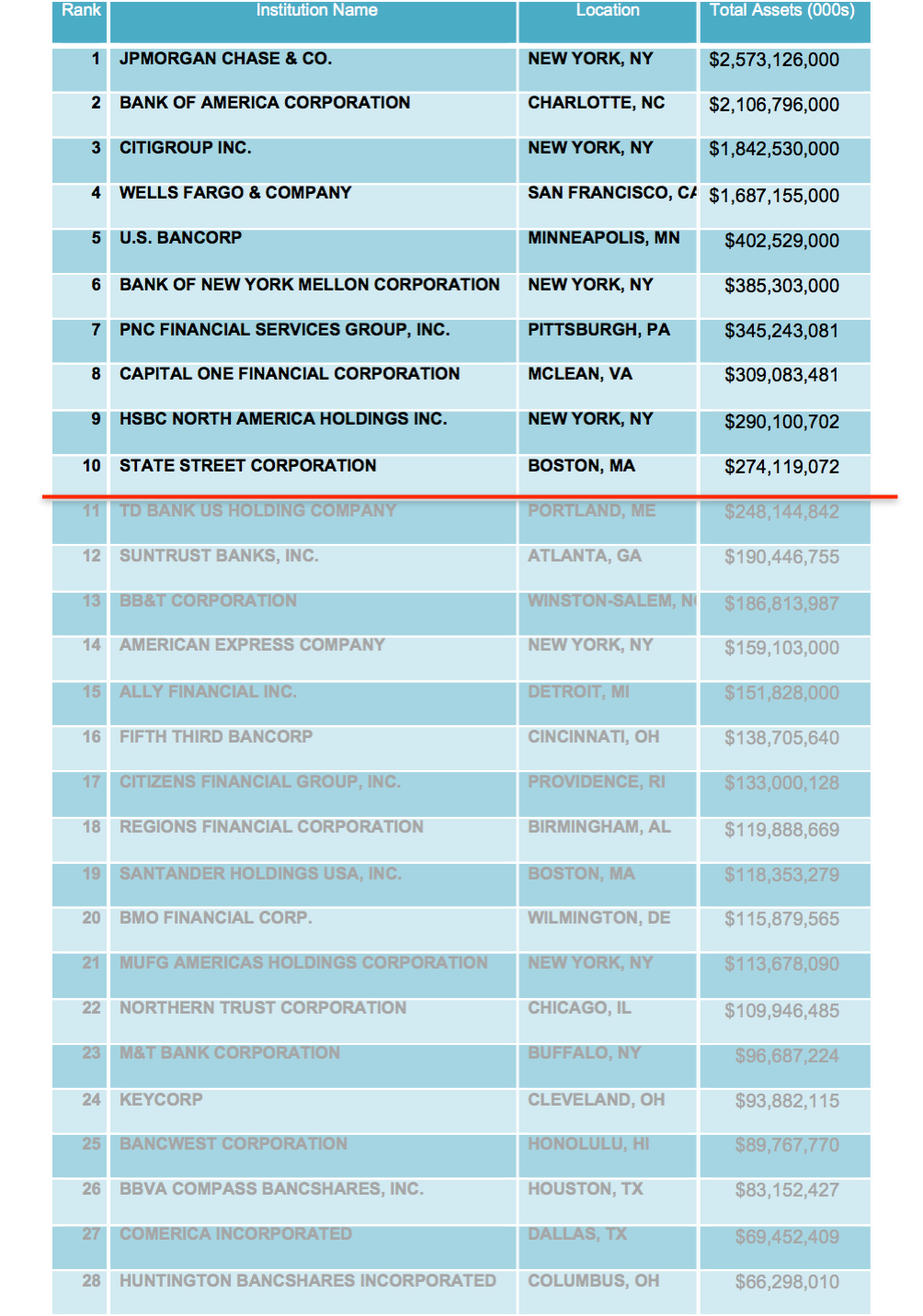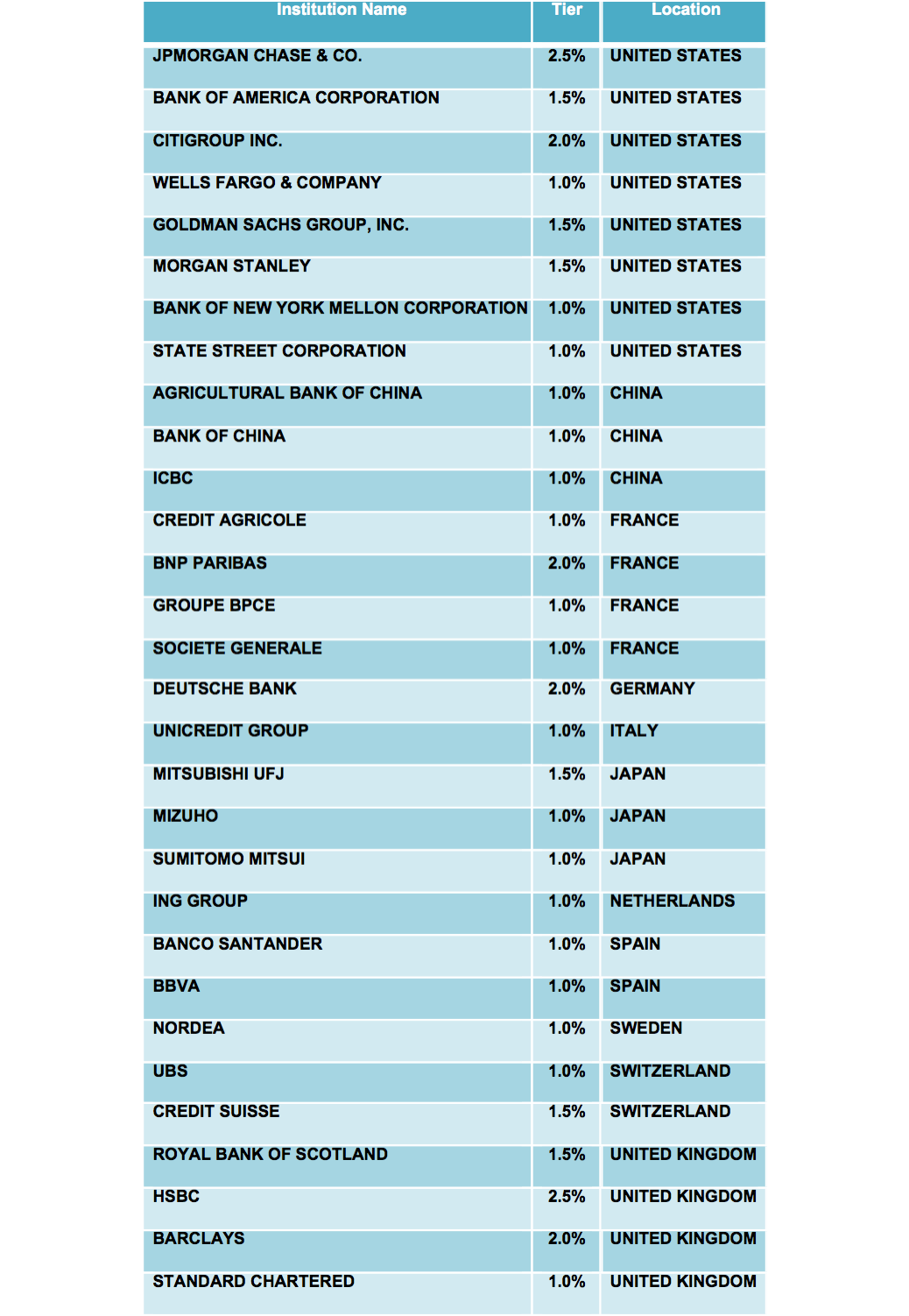Impact of Basel I, Basel II, and
Basel III on Letters of Credit
and Trade Finance
Impact of Basel I, Basel II, and
Basel III on Letters of Credit
and Trade Finance

Color Code Key (US Applicability):
(Applies only in the US)
In the US, applies only to “Large, Internationally-Active Banks”
Applies to “Global, Systemically-Important Banks”
* The amount of Risk-Weighted Assets (“RWA”) is computed by multiplying the amount of each asset and contingent asset by a risk weighting and a Credit Conversion Factor (“CCF”) and adding them all up.
• Under Basel I, risk weightings are set: 0% for sovereign obligors, 20% for banks where tenors ≤ one year, 50% for municipalities and residential mortgages, 100% for all corporate obligors.
• Under Basel II, risk weightings are based on either internal or external (rating agency) risk ratings with no special distinction for banks; capital requirements for exposures to banks are increased by as much as 650% (from 20% to as much as 150%).
• The Credit Conversion Factor for Letters of Credit varies under Basel I vs. Basel II and Basel III:
+Under Basel I, this is 20% for commercial L/Cs, 50% for performance standbys and 100% for financial standbys; confirmation of a commercial letter of credit has a capital requirement of 0.32% (8% x 20% x 20%).
+Under Basel II and III, “Advanced Approach Banks” are required to do a statistical analysis of losses based on structure (and, due to limited losses, there are insufficient loss data for any bank in the world to do this for letters of credit, resulting in using the default CCF of 100%). Under Basel II, the capital requirement to confirm a letter of credit can jump from 0.32% to 12% (8% x 150% x 100%).
+ Under Basel III, exposures to regulated financial institutions with assets of over USD100 billion and to all unregulated financial institutions must be multiplied by an additional factor called the Asset Value Correlation (AVC). The capital requirement to confirm a letter of credit can be as high as 29.0625% (15.5% x 150% x 100% x 1.25), almost 100 times the requirement under Basel I.
* In the US, Basel II only applies to “Large, Internationally-Active Banks”—the 10 largest commercial banks fit the definition—and has never been fully implemented. Basel III-Advanced is applicable to the same banks while Basel III-Standardized applies to all US banks.
* Basel III-Standardized is not the same in the US as in the rest of the world. Outside the US, it uses risk weightings based on rating agency ratings; as such use of rating agency ratings is now prohibited by in the US by the Dodd-Frank Act, risk weightings for sovereign obligors and for banks are based on Country Risk Classifications (CRCs) set by the OECD and range from 0% for sovereign obligors and 20% for banks to 150% for both, while the risk weighting for all corporate obligors is 100%, the same as under Basel I.
* The Capital Conservation Buffer distinguishes what used to be called “well-capitalized banks” and is, essentially, required. Thus, the capital requirement for even a small bank becomes 10.5% in 2019, compared with 8% under Basel I and Basel II.
* The Additional Loss Absorbency requirement applies only to “Global, Systemically Important Banks”; this is presently 30 of the largest banks in the world.
* Depending on the bank and the point in the economic cycle, under Basel III, the total capital requirement for a large bank in 2019 may be as much as 15.5% of Risk-Weighted Assets (“RWA”).
* The Leverage ratio does NOT apply risk weightings but does apply Credit Conversion factors to loan commitments and commercial and performance letters of credit.
* In the US, banks with more than $700 billion in assets are required to maintain a Leverage Ratio of 5% of Tier 1 Capital to total direct and contingent assets and there is an additional requirement that Total Capital be at least 4% of direct assets.
* “Liquidity Coverage” has to do with cash inflows and outflows.
•In the U.S., banks with USD50 billion – USD700 billion in assets will be required to project, each month-end, their cash inflows and outflows for the next month and to hold “High-Quality, Liquid Assets,” like US Treasury Bills, equal to 70% of the net outflow amount .
•Banks with over USD700 billion in assets will be required to project the net outflow for each day over a 30-day horizon and hold HQLAs equal to 100% of the net outflow with a peak-day maturity mismatch add-on.
•Banks must hold a minimum of 25% of gross outflows in HQLAs.
•Banks below USD50 billion in assets are exempt from the liquidity coverage requirements.
* Deposits and loan commitments are examples of outflows; outstanding loans maturing in the next 30 days are examples of inflows.
•Loans for corporate borrowers get a 50% “haircut” in terms of expected repayment when due.
•Fixed-term loans to regulated financial institutions get no haircut; banks are expected to pay 100% of their borrowings when due; this makes loans to, and discounted bankers’ acceptances for, foreign banks equal to HQLAs during their final 30 days till maturity.
•The U.S. regulators have indicated that letters of credit should be treated like loan commitments, but, except for certain standbys that front liquidity facilities, it is unclear whether this only applies to the projected payments or also to projected reimbursements.
Banks designated as Global Systemically-Important Banks
as of November 2014
* Each bank receives a score based on (1) size, (2) cross-jurisdictional activity, (3) interconnectedness, (4) substitutability/ financial institution infrastructure, and (5) complexity
* Score places each institution in a bucket with additional loss absorbency requirements from 1.0% to 2.5% (potentially 3.5%)
US Commercial Banks meeting the definition of “Large, Internationally-Active Bank”
(over USD250 billion in assets or over USD10 billion in on-balance-sheet foreign exposure)
as of December 31, 2014

Risk Weights for Exposures to Foreign Banks
under Basel III-Standardized Approach in the US
*Country Risk Classifications (CRCs) are set by the OECD
(available at http://www.oecd.org/tad/xcred/crc.htm)


